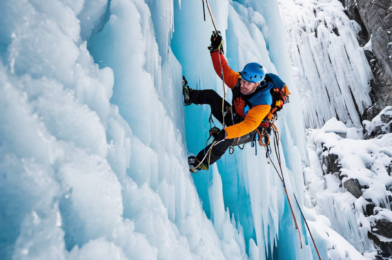Along with movement, climbers must master the use of ice tools. These are crucial for balance, stability, and propulsion. Climbers should practice swinging their tools effectively, aiming for precise placements that provide secure and stable anchoring. Techniques such as the “figure four” and “figure nine” swings help with steep terrain and allow climbers to propel themselves upward. Additionally, climbers need to be adept at using their tools in a self-arrest technique, which can stop a fall and save one’s life.
Route selection and planning are critical factors in ice climbing. Climbers must assess the ice conditions, taking into account factors such as ice thickness, texture, and the presence of bulges or overhangs. Understanding the grading system for ice climbs is essential, as it provides valuable information about the climb’s difficulty and characteristics. Climbers should also be aware of potential hazards, such as ice fall, melting ice due to sunlight exposure, or hidden cracks that can compromise the structure’s integrity.
Safety is paramount in ice climbing, and climbers should always use proper protection and adhere to established safety protocols. The use of ropes and anchors is fundamental, and climbers should be proficient in placing screws efficiently and effectively for reliable protection. Knowledge of belaying techniques and rope management is imperative for the safety of oneself and one’s climbing partner. Additionally, climbers should always be prepared for changing weather conditions and carry essential items like extra clothing, headlamps, and first aid supplies.
Mastering the art of ice climbing involves a combination of physical strength, technique, and strategic planning. It requires climbers to embrace the challenges presented by the ever-changing ice and to develop a deep understanding of their own bodies and movement capabilities. Through practice, perseverance, and a commitment to safety, climbers can ascend breathtaking ice formations and experience the unique thrill and beauty of this vertical environment.
Ice climbing, an extreme sport to some, offers a unique and challenging experience that tests one’s physical and mental limits. It attracts adventurers seeking unparalleled experiences in nature’s most breathtaking and rugged landscapes. With proper guidance and a systematic approach to skill development, climbers can safely enter this frozen realm and discover the indescribable beauty and sense of accomplishment that ice climbing affords. So, for those drawn to the allure of frozen waterfalls and icy summits, let the adventure begin!
While ice climbing may appear daunting to newcomers, a systematic approach to skill development can pave the way for success and a lifetime of enjoyable climbing experiences. Here’s a breakdown of the key skills that will help aspiring ice climbers master this challenging but rewarding sport. By breaking down the components of ice climbing into manageable segments, anyone can develop the necessary skills and confidence to tackle frozen climbs safely and effectively.
Bewegungstechnik, as the Germans call it, or the “technique of movement,” is fundamental to ice climbing. It involves the efficient transfer of weight and a deep understanding of one’s center of gravity. Climbers must learn to confidently place their crampons, using front-pointing for steep sections and flat-footing for resting and balance. Practicing these techniques in a controlled environment, such as an indoor climbing gym, allows climbers to develop muscle memory and refine their footwork before tackling more challenging outdoor routes.
The use of ice tools is another critical skill. Climbers should focus on precise and powerful swings that result in secure placements. Techniques such as the “figure four” and ” figure nine” swings help with steep ascents, providing upward propulsion and stability. Additionally, climbers must practice self-arrest techniques to stop themselves in the event of a fall. This requires quick reflexes and the ability to effectively plant one’s tool in the ice to bring oneself to a halt.
Safety is of utmost importance in ice climbing, and climbers should never compromise on protective measures. The placement of screws for anchoring and protection against falls is a skill that requires practice to perfect. Climbers should strive for efficiency and precision when placing screws to maximize their safety. Moreover, climbers must be well-versed in belaying techniques, ensuring they can safely support their climbing partner and manage the rope effectively.
Route selection and planning are other aspects that set apart experienced ice climbers. Understanding the grading system and assessing ice conditions, including thickness, texture, and the presence of obstacles, are vital for a successful and enjoyable climb. Being aware of potential hazards, such as melting ice or hidden cracks, helps climbers anticipate challenges and make informed decisions. Carrying essential gear, including warm clothing, headlamps, and first aid supplies, is also part of responsible planning.
In conclusion, ice climbing offers a unique and challenging experience that blends physical strength, refined techniques, and strategic thinking. Through dedication to practice, a deep understanding of safety protocols, and a keen awareness of one’s surroundings, climbers can master this vertical realm and unlock unforgettable adventures in some of nature’s most breathtaking locations. With the proper guidance and a step-by-step approach, anyone can embark on the exhilarating journey of ice climbing and discover its captivating appeal.









